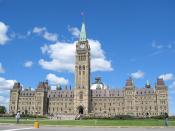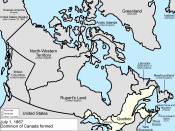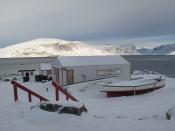Highlights of the Agreements Divided from the eastern part of the Northwest Territories, Nunavut, a vast region of Canada's frozen north is part of a promising hope for the future of its people. Mostly populated by the Inuit who were its original inhabitants, the formation of Nunavut and its agreement is an opportunity for this aboriginal group to create a self-sustaining economy.
Through the Nunavut agreement, the people on this land gained the right to create their own system of government that, compared to the previous system, can best suit their society. "A Nunavut Implementation Commission will be formed immediately to design the new government, plan the first election, select the new capital (or capitals), and administer training" (Highlights of the Agreements). Prior to the establishment of Nunavut, all main government decisions were made in the south and the needs of the Inuit were neglected. Mainly because of distance, capitals that are required to create any significant positive investments for this arctic economy is saw to have a very low return, in comparison other available investments, and as a result the federal government of Canada more or less ignored this part of the country.
Now this government, based in Nunavut rather than Ottawa, operated by its own people rather than outsiders who very often have a different view on the situation in the north, can focus on meeting the needs of its people, economy and environment. It is when these needs are met that Nunavut can have a chance in becoming self-sustaining.
Along with authoritative power, the federal government also agrees in providing a periodic fund for Nunavut, which in turn can aid in building the fundamental establishments for this society. "The federal government will pay $1.15 billion to Inuit over 14 years. The Nunavut Trust will be set up by Inuit to receive this capital (tax-free) and to be responsible for protecting, managing and investing it" (Highlights of the Agreements). These responsibilities of protecting, managing and investing are also the first step in being self-sustainable. Similar to the newly granted authoritative power in Nunavut, the government in this area can decide on the delegations of its capitals and invest it in projects that can help make their society more sustainable.
Contrastingly, some may argue that the government grants given over a 14 year period to Nunavut is miniscule, but we must take note that the key to become self-sustainable is through growth and investment. This sum of money is enough for Nunavut to invest in the training of professionals, major projects (such as biotechnological development that can allow them to grow their own food) and businesses that can bring money in from outside their economy (such as tourism). This grant, in all is enough to have impacts through investments to lower unemployment and to create a system where the society is reliant on itself rather than outside suppliers.
Also from the agreement, the Inuit retains the right to resources within their land. This is one of the main keys to the future economical development of Nunavut. "On 36,257 square kilometers of their deeded land, Inuit will own the subsurface rights to oil, gas and minerals" (Highlights of the Agreements). The extraction of these resources will result in direct monetary gain and also indirect gain for the economy such as creation of new jobs.
Presently this arctic economy is relatively insulated from the intense population and resources that the rest of the Canada is experiencing but through the Nunavut Agreement and the establishment of this new territory, we can expect to see a great deal of social, economical and political renewal in the near future that will result in a formation of a very self-sustaining part of Canada.



